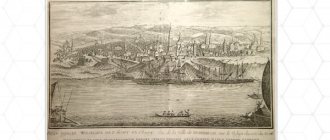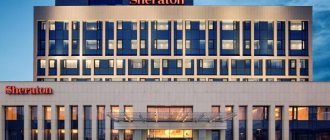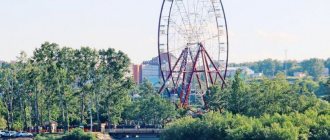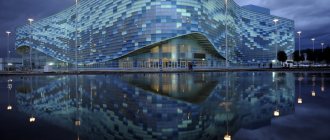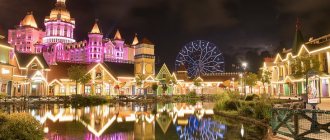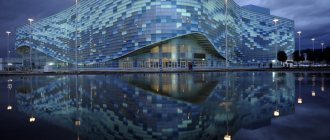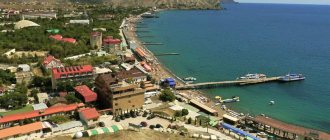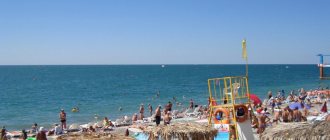The city of Cheboksary is located on the banks of the majestic Volga River in the Republic of Chuvashia; a large number of tourists from all over Russia come here every year to see its sights. Like many cities in the Volga region, it was founded in the 15th-16th centuries, or more precisely, in 1469, by voivode Ivan Runa, who noted the beneficial advantages of this place and ordered the establishment of a settlement here. In the future, the main trade routes began to pass through this place, so it is not surprising why the city gradually turned into a major cultural and social center.
How to get there?Population and cultureRestaurantsHotelsSights
Temples and Churches: Cathedral of the Archangel Michael in CheboksaryChurch of the Resurrection of Christ in CheboksaryChurch of the Assumption of the Mother of God in CheboksaryCheboksary Vvedensky CathedralCheboksary Intercession-Tatian Cathedral
Places for recreation and walks: Cheboksary Botanical Garden Cheboksary Bay Cheboksary Culture and Leisure Park Singing Field in Cheboksary Cheboksary Square named after. I. Ya. YakovlevaMerchant Efremov Boulevard in CheboksaryCheboksary Victory Memorial Park
Museums, cultural institutions and architectural monuments: Cheboksary Distillery Chuvash Opera and Ballet Theater Chuvash State Agricultural Academy Chuvash Drama Theater Chuvash National Museum Beer Museum in Cheboksary National Library of the Chuvash Republic M. Sespel Museum in Cheboksary V. I. Chapaev Museum in Cheboksary House of F.P. Efremova in CheboksaryMonument to V.I. Chapaev in CheboksaryCheboksary zero kilometerMonument to the Patroness Mother in Cheboksary
watch excursions around Cheboksary
Today Cheboksary is a modern city with its own architecture and a number of monuments, not to mention numerous museums and other interesting places.
Mother Monument
Among the attractions of Cheboksary, the central object is the decoration of the main embankment and the entire city - the “Mother Patroness” monument.
Story
The monument was erected in 2003, it was designed by the famous sculptor Vladimir Nagorny. The idea of creating a majestic sculpture belongs to the first president of Chuvashia N.V. Fedorov. The sculpture personifies the boundless and devoted love of a mother for her children.
Description
The sculpture depicts a generalized image of the mother. A woman of Chuvash nationality in traditional clothes, with a pendant of coins on her head. She stands with her arms outstretched, the author showed patronage and care in this gesture. The height of the composition is 16 meters, it is installed on a 25-meter pedestal. National symbols are depicted not only on the sculpture itself, but also on the pedestal. Here you can see oval niches as a symbol of the high sky, as well as signs of fire and the sun. The parting words are written in two languages: “Blessed are my children who live in peace and love.”
Cheboksary Bay
Cheboksary Bay is the water area of the city, as well as one of the favorite vacation spots among local residents and tourists.
Story
In the early 80s, active construction of the Cheboksary Hydroelectric Power Station was underway. In order for it to operate at full capacity in the future, it was necessary to build a bay. Construction of the upper part lasted from 1978 to 1987, and the construction of the Lower part was completed in 2000.
Modernity
Cheboksary Bay today consists of two dams and small rivers flowing into them. Around the bay there are city squares, streets, and the Singing Field. Over the course of several decades, the surrounding area has been improved. Nearby is the famous monument “Patroness Mother”, Victory Park, and the Alley of Love.
The bay embankment is a popular place for a leisurely promenade. There are cafes and entertainment venues here, as well as mass folk festivals.
Photos of Cheboksary
Cheboksary: Photos Weather Map Flights Hotels
Countries of the worldRussiaCitiesCheboksary
1
This collection contains 69 photographs of Cheboksary, its views, houses and attractions, which were taken by local residents, tourists and photographers. All photos of Russian cities and attractions are presented in high quality, we hope that this will help you get to know them better.
VKontakte facebook twitter
Photos of other Russian cities Photos of Moscow Photos of St. Petersburg Photos of Sochi Photos of Tula Photos of Yaroslavl Photos of Vladimir Photos of Voronezh Photos of Yekaterinburg Photos of Ryazan Photos of Tver Photos of Sevastopol Photos of Dmitrov Photos of Rostov the Great Photos of Ivanovo Photos of Orel Photos of Nakhodka Photos of Belgorod Photos of Bryansk Photos of Volgograd Photos of Kazan Photos of Kaluga Photos Krasnodar Photo Lipetsk Photo Nizhny Novgorod Photo Penza Photo Samara Photo Saratov Photo Smolensk Photo Tambov Photo Chelyabinsk Photo Anapa Photo Kolomna Photo Yuzhno-Sakhalinsk Photo Vladivostok Photo Grozny Photo Izhevsk Photo Kostroma Photo Kursk Photo Omsk Photo Perm Photo Rostov-on-Don Photo Ufa Photo Cheboksary Photo Chita Photo Kerch Photo Pushkin Photo Sergiev Posad Photo Murom Photo Yeisk Photo Abakan Photo Saransk Photo Dolgoprudny Photo Balashikha Photo Irkutsk Photo Kirov Photo Novosibirsk Photo Orenburg Photo Podolsk Photo Ulyanovsk Photo Essentuki Photo Magadan Photo Alushta Photo Mytishchi Photo Krasnoyarsk Photo Togliatti Photo Khabarovsk Photo Myshkin Photo Kaliningrad Photo Rybinsk Photo Stavropol Photo Suzdal Photo Tomsk Photo Tyumen Photo Pyatigorsk Photo Ukhta Photo Astrakhan Photo Blagoveshchensk Photo Murmansk Photo Novorossiysk Photo Pskov Photo Ulan-Ude Photo Gelendzhik Photo Uglich Photo Pitkyaranta Photo Arkhangelsk Photo Barnaul Photo Vologda Photo Yoshkar-Ola Photo Kemerovo Photo Kurgan Photo Magnitogorsk Photo Nalchik Photo Surgut Photo Taganrog Photo Yakutsk Photo Simferopol Photo Balakovo Photo Svetlogorsk Photo Ordzhonikidze Photo Zheleznovodsk Photo Engels Photo Komsomolsk-on-Amur Photo Armavir Photo Vladikavkaz Photo Makhachkala Photo Norilsk Photo Tuapse Photo Yalta Photo Torzhok Photo Ples Photo Alexandrov Photo Volgodonsk Photo Angarsk Photo Bratsk Photo Naberezhnye Chelny Photo Novokuznetsk Photo Syzran Photo Cherepovets Photo Sudak Photo Veliky Novgorod Photo Kislovodsk Photo Kalyazin Photo Mineralnye Vody Photo Kovrov Photo Belokurikha Photo Pereslavl-Zalessky Photo Sortavala Photo Derbent Photo Petrozavodsk Photo Syktyvkar Photo Feodosia Photo Novocherkassk Photo Vyborg Photo Kozelsk Photo Elista Photo Balaklava Photo Foros Photo Nizhnevartovsk Photo Petropavlovsk-Kamchatsky Photo Pechory Photo Salekhard Photo Tobolsk Photo Valdai Photo Yuryev-Polsky Photo Nizhny Tagil Photo Severodvinsk Photo Anadyr Photo Zadonsk Photo Khanty-Mansiysk Photo Priozersk Photo Vorkuta Photo Temryuk Photo Dzerzhinsk Photo Kirzhach Photo Gatchina Photo Kronstadt Photo Elabuga Photo of Veliky Ustyug Photo of Maykop Photo of Staraya Russa Photo of Miass Photo of Khasavyurt Photo of Shlisselburg Photo of Alupka Photo of Bakhchisarai Photo of Peterhof Photo of Palekh Photo of Velikiye Luki Photo of Baltiysk Photo of Gus-Khrustalny Photo of Igarka Photo of Nevyansk Photo of Nerekhta Photo of Kidekshi Photo of Verkhoturye Photo of Shchelkino Photo of Dalmatovo Photo of Ostashkov Photo of Chernyakhovsk Photo of Gorokhovets Photo of Ussuriysk Photo of Sterlitamak Photo of Zelenogradsk Photo of Neman Photo of Sovetsk Photo of Polessk Photo of Severomorsk Photo of Roslavl
Cheboksary
Description Photos Weather Map Flights Hotels
See also: Photos of Lake Constance, Cities of Azerbaijan, Ghana, Rethymno, Surgut, Mzab Valley, Sultan Omar Ali Saifuddin Mosque
Boulevard of Merchant Efremov
The central pedestrian zone in the city is Merchant Efremov Boulevard. In appearance and territory it is similar to Moscow Arbat. There are a large number of architectural monuments along the street.
Story
The boulevard bears the name of the famous merchant P.E. Efremov, the founder of the famous dynasty. He and his heirs made a great contribution to the development of the city and its improvement. The ancestral house of the dynasty was built on the site of the current boulevard in 1884. Over the course of many years, one after another, other mansions began to be built on the street, belonging to the merchant’s relatives.
Current state
Taking a walk along the boulevard, you can see various architectural buildings from the 19th-20th centuries.
- Monument to Ostap BENDER and Kisa VOROBYANINOV
- Beer Museum
- Geological Museum
- Red Square
In addition, during your walk you will see fountain compositions and monuments. The recreation area is equipped with benches, flowers and trees grow everywhere.
Where to go for a walk, entertainment with children
The best places for walks in Cheboksary are the picturesque boulevards, squares and parks of the city, Moskovskaya Embankment, Cheboksary Bay, and the Botanical Garden. The city has many beaches where you can go during the summer season. With children you can visit the Children's Park named after. A.G. Nikolaev, where there are many attractions, there is a mini-zoo, animators work and a rope town. Here you can ride ponies and horses, rent bicycles and roller skates.
There are specialized rope parks in the city: “Banzai”, “Belka Park”, “#Prostopark” and “Rope”, where children of any age can complete routes of varying difficulty. In winter, the parks have skating rinks and rent skates, skis and sleds. The city of Cheboksary is rich in historical sights and interesting places where you can go, even if you come for just 1 day.
Chuvash Opera and Ballet Theater
One of the central cultural sites is the Chuvash Operetta and Ballet Theater. A large number of performances of different genres take place on its stage.
Story
The history of the theater began in 1960 with the premiere of the first national opera of Chuvashia - SHYVARMAN. The first director of the theater and main leader was Boris Markov. For the first time in 1967, a ballet performance was staged on stage - Giselle.
The theater developed rapidly, but lacked professional staff and a new building. In 1986, the troupe moved to a new complex. In 1993, the theater completely changed its structure and became the Chuvash State Opera and Ballet Theater.
Modernity
The theater troupe is known far beyond the borders of Cheboksary and Chuvashia. Their repertoire includes over 160 productions and they are festival winners. The Opera and Ballet Theater does not stand still; it develops every year, educating a new generation of artists.
Interesting mountains and hills of the Chuvash Republic
And although Chuvashia is located on a plain, mountains also have a place here. And although there are very few of them, the quantity pays off in quality - they offer amazing views of the Volga region.
Chardu Slope
- Coordinates on the map: 55.800000, 47.983333.
The mountain in the Kozlovsky region got its name from the word “king”, which is pronounced “Char” in the Chuvash language. Here, during the Russian-Kazan war, Ivan the Terrible stood with his army, and after that he even wanted to build a fortress on the top. But the lack of water and the impossibility of delivering it to the top changed his plans.
Legend says that he left a treasure on Chardu, which still cannot be found. The slope today belongs to specially protected areas. The nature here is as wild as it gets, and any economic activity is prohibited. The top of the mountain is an excellent viewing platform for the valley of the Anish River.
Sovereign Mountain
- Address: Mariinsky Posad.
Another mountain, which received its name in honor of the royal person, is located near the small town of Mariinsky Posad. Catherine II stayed here when she went to Kazan. A feast was held in honor of the Empress at the top of the mountain, and the hill itself began to be called the Sovereign.
A few years after the memorable visit, the Catherine oak grove was founded in the vicinity of the mountain, which today is one of the main attractions of the area. And at the top, treasure hunters are still looking for the gilded spoon dropped by the empress during the feast.
Cape Bird's Flight
- Coordinates: 55.870094, 48.208385.
The Volga, the Kazan backwater, the mouth of the Anish River, the forests of Mari El... - all this can be seen by climbing to the best observation deck and the highest point of Chuvashia. Its height above sea level is 190 m and the name speaks for itself. And who doesn’t want to see all this beauty from a bird’s eye view? It is located near the village of Novorionovka, Kozlovsky district.
Beer Museum
One of the interesting and unusual attractions of Cheboksary is the Beer Museum. During the tour, you can learn the history of the intoxicating drink, as well as take part in a tasting.
Story
For many centuries, most of the hops were grown in Chuvashia. Today, almost every family has its own ancient recipe for making an intoxicating drink. In folk culture, beer was used for pleasure and as a remedy.
The Beer Museum was founded in 1997 by decree of the President of the Republic N.V. Fedorov.
What can you see
During the tour you will be able to see many objects on the topic of beer, its production and history. Visitors will learn why Emperor Alexei Mikhailovich prohibited the production of beer and its sale, as well as where the tradition of brewing began and how it “reached” Chuvashia. After viewing the exhibits, guests will be invited to a special room for a tasting.
River port
The river port in Cheboksary is not only an important transport hub, but also a landmark of the city.
Story
The history of the water harbor dates back to 1917, when a small pier for steamships was built on the river bank. Over the decades, there has been active development, and in 1968 the pier received the status of a port and became part of the Volga River Shipping Association.
Current state
The river port includes five passenger berths, as well as a cargo berth equipped with all the necessary equipment. Throughout the year, the water area receives about 400 tourist ships plying along the Volga.
In addition, the port produces and supplies river sand, as well as rents out and repairs river vessels of various modifications.
During your walk, you will be able to see a sculpture of Alexei Krylov, a talented mathematician and academician. Near the port there is a city embankment where holidays, festivals and concerts are held.
City `s history
The first mention of Cheboksary in historical chronicles appeared in 1469. This date is considered the year the city was founded. In those days, this settlement was located on the banks of the Cheboksary River (the right tributary of the Volga, flowing through the city), along the route of Russian troops from Moscow to Kazan and was called “Cheboksary”. According to research conducted by scientists at archaeological sites, the first settlement on the site of the city of Cheboksary was formed in the 13th-14th centuries.
On the right bank of the Volga River, the Suvar (Chuvash) tribes, who fled from the invasion of the Arabs along with the Khazars, built a settlement called Vata Suvar. It was he who became the basis for the formation of the modern city of Cheboksary. In May 1555, a fortress was founded here on the shore, and then the Cheboksary district was formed. This happened after the Chuvash lands were designated part of the Moscow state.
In the same year, on behalf of Ivan the Terrible (Ivan IV), the site for the construction of the Kremlin was consecrated, which was erected in a short time. By the end of the 17th century. the city became a trading center of the Volga region and a province of the Kazan province. This time was marked by the flourishing of stone architecture. Before this, almost all buildings in Cheboksary were wooden. Numerous fires that regularly broke out in the city forced residents to build stone houses.
In the 18th century Many churches, city administrative and private buildings were erected here. As a result, the settlement became the largest on the lands of Chuvashia. In the 19th century Trade is flourishing in Cheboksary. In addition, industrial enterprises of various production types operate here. It is noteworthy that all the main roads of the settlement lead to Moscow and Kazan.
In 1920, the city of Cheboksary became the capital of Chuvashia, which was recognized as an autonomous region. And in 1925 - the capital of the Chuvash ASSR (Autonomous Soviet Socialist Republic). In 1958, the city had more than 100,000 inhabitants. Today Cheboksary extends over an area of 251 square meters. km and is an urban district. It has about 500,000 inhabitants of different nationalities.
Russian Drama Theater
One of the central cultural sites is the Russian Drama Theater.
Story
The Russian Drama Theater was founded in 1918; initially it was an amateur group, which included several people. Every year the troupe was replenished with talented children, and in 1922 the first professional premiere took place - the drama “Vasilisa Melentyev” by Alexander Ostrovsky.
During the Great Patriotic War the theater continued its existence. The troupe went to the front with their performances. During the war years they staged over 300 performances.
In 1982, the theater moved to the building that once housed the city Philharmonic and Youth Theater.
What to see
The auditorium has a capacity of 530 seats, the interiors are decorated in the traditions of post-war architecture. The poster consists of performances staged based on Russian classical works.
Museum of V. I. Chapaev
There are a large number of museums in the city, one of the popular ones is the V. I. Chapaev Museum. The complex is part of the Chuvash National Museum. The main goal of the museum is to collect, study, and preserve documents that reflect the events of the Civil War. The institution includes the museum building, the house of the commander’s parents, a memorial wall, as well as a sculpture of Vasily Chapaev.
Story
The museum was opened in 1974 with funds allocated by enterprises and companies of the city. The location was not chosen by chance; nearby is the house where Vasily Ivanovich spent his childhood.
What to see
During the tour you will be able to view several exhibitions. One of them talks about the life of the commander, his childhood and youth. Signature items are stored here, including a black cloak, a hat and weapons. In addition, you will be able to view awards, photographs, letters, and medals. The exhibits on display make it possible to know Chapaev not only as an outstanding commander, but also as an ordinary person.
Districts and real estate Cheboksary
Officially, the city is divided into four districts, one of which is located on the left bank of the Volga River and consists of a number of small villages, camp sites, cordons and sanatoriums. Getting there is not very convenient - either by public and private transport via hydroelectric power stations at any time of the year, or by trams and ferry in the summer. You won't be able to swim - it's too far. There is no bridge - it is expensive to build. The remaining areas are separated by bridges. The breakdown in numbers is approximately as follows:
Kalininsky district - 150 thousand, Leninsky -123 thousand, Moskovsky -184 thousand people. The Volga region has about 12 thousand.
Map of Cheboksary districts
As you can see on the map, each of the four districts is divided into several more territories, which, however, bear quite official names. However, this is not all. Each of these districts is still divided into small territories, which received their names in the fascinating and turbulent 90s, when the so-called “boy” groups existed in the city, strictly guarding their halo of habitat. Many of them ceased to exist long ago, but the names remained in the minds of the townspeople. The “boys” have matured, put on suits, ties, some even cufflinks, but they still remember where their homeland is and whose blood they will be from.
The Moscow region is considered the most respectable. At least, the cost of housing here is the most expensive in the city, except for new houses in the center and a number of elite houses in the KhBK area. The average cost of a residential square meter in the Moscow region varies from 35 to 55 thousand rubles. It all depends on the type of building and location. The most expensive squares are in the area of Historical Hill or, as people say, Brick (there is an old brick factory on this territory), as well as in the North-Western microdistrict in the territories called Volzhsky-1, Volzhsky-3 and st. Talvira. The first president of Chuvashia lives here with his former officials, as well as the current nomenklatura fraternity and large businessmen.
New buildings in the Moskovsky district
There is a small village with large cottages called New Village. The cost of a land plot of 15 acres can reach up to 35 million rubles. The area of the former hippodrome, now the intersection of Moskovsky Prospekt and st., is also considered prestigious. Afanasyeva. There is practically no industry in the Moscow region, with the exception of the instrument industry, which produces units for avionics. The plant not only remained afloat, but also successfully replenishes the city’s treasury.
As for other parts of the region, they are significantly inferior in prestige to the North-West. True, it is worth noting that the South-Western region is distinguished by fairly decent houses in architecture and layout. However, the distance from the center and the Volga makes housing relatively inexpensive. About 30-35 thousand per square meter. Young families live here who have taken out a mortgage and are successfully paying for it. And also businessmen who managed to earn money for a two- or three-room apartment in two or three years. The place is quite comfortable.
As for the Chapaevsky village, it is a very interesting place. Built around the plant. Chapaev, he preserved the amazing atmosphere of provincial architecture. Many of the houses were built by German prisoners of war, which makes them incredibly cute. Everyone here knows each other. There are many elderly people who take special care of their flower beds and front gardens. Old engineers and designers who settled in the city after the construction of the plant began live here. They love and value their area. However, this area is popularly called the Village. The most desperate bandits and hooligans were from here. The city at one time was in awe of the “villages”.
Chapaevsky village
Leninsky district is a rather motley sight. The Center microdistrict is Karl Marx Street with administrative buildings and Republic Square, as well as the pearl of the city - the Bay - beautiful, clean and green.
Leninsky district
Everything else is essentially a ghetto. Bogdanka is an old two-story barracks, with amenities on the street and wood sheds, which are used both as warehouses and for their intended purpose. The only area in the city where you don’t want to not only live, but also just stop by on business. And there can be no business there. The road to the main city cemeteries runs through Bogdanka.
Dilapidated houses are a common sight on Bogdanka
True, the city has a development plan for this area. New houses began to appear, infrastructure was developing. People are waiting for changes and rejoicing at the emerging prospects.
Geographical center of the city
As for the Kalininsky district, it also consists of sectors with different quality of life.
The KhBK microdistrict is considered one of the most prestigious. This is due to both the location and those who settled here. Directors of large factories - active and not so much, ministers, the new head of the Republic, they all live next door. We can say that this is the cleanest and most well-groomed area of the city. Evenly trimmed linden trees, beautiful flower beds, repaired roads, constant lighting - all this pleases the inhabitants of the area. It should be noted that some of the houses here resemble the Chapaevsky village in their architecture, only they look like the houses of a German suburb - picturesque and alluring. Very good area. And since, thanks to the activities of the former president, the Cotton Mill ceased to exist, next to the area there is one of the largest shopping centers in the city, Mega Mall, located in industrial buildings.
But the most important attraction of the area is Victory Park. Blue spruce trees and an unforgettable view from the highest point of the city allow the inhabitants of this closed little world to enjoy peace and well-being.
View from Victory Park
Perhaps the most expensive real estate is here. Some apartments cost about 12-15 million rubles. True, their area is corresponding from 150 to 350 square meters. There are also small apartments. They are much cheaper. But it is extremely difficult to buy housing here.
Not far from this oasis of well-being are the districts “Chulochki” and “Agregatki”, in other words, the districts formed thanks to the Hosiery and Knitting Factory and the Aggregate Plant. These are working-class areas. Living here is not prestigious, but it is inexpensive. The bulk of visitors from villages settle here. It was so 40 years ago, and it is so now. The houses for the most part are brick buildings of 4-5 floors from the Khrushchev period of our history. There are many hostels built for working youth, who, having matured significantly, stayed to live here. A lot of everyday alcoholism and family dramas. However, children are having fun in the courtyards. The neighborhoods are noisy and fun. It is here that all the local district punks fear the watchful old women who stand guard over public and personal morality.
As for the New South district, it is the largest and most populous in the entire city.
Novo-Yuzhny
Built for the workers of the Tractor Plant, the area began to grow rapidly. Initially, young and not very specialists who came from all over the USSR lived here. They brought the wind of freedom, glimpses of a new mind, the smell of unprecedented dishes and forbidden literature. Engineers, chemists, metallurgists and techies, so attractive in the seventies, have firmly established themselves in this young part of the city. As time went. The plant needed a lot of new labor, and the area acquired new residents. The same young, as strong and healthy workers as the first wave of migrants. But they spoke mostly Chuvash and did not know who Feuerbach was. But they knew that the plant would certainly provide them with housing and good wages.
And the Tractor Plant did not deceive them. New houses were built, wide avenues ran through, and infrastructure was developed. Today's New South district is an area of fast monolithic houses, not very expensive shops and an incredible number of residents. Inexpensive, fun, noisy. As a rule, residents living here, when going to the Center or the North-Western region, notify their family, saying that they are “going to the city.”
Holy Trinity Monastery
One of the oldest complexes in Cheboksary is the Holy Trinity Monastery.
Story
Ivan the Terrible in the middle of the 16th century, after the capture of Kazan, gave the order for the construction of an Orthodox church so that local residents could gain the Orthodox faith. In 1566, the temple was consecrated and operated until 1609, when it was destroyed and burned by rebels.
The new monastery was built of stone, in order to avoid the fate of the first monastery. During Soviet times, various public institutions were organized here. In 1946, the building was included in the list of architectural monuments of the city. The monastery resumed its main activities in 1993 and is still active today.
Vvedensky Cathedral
The Vvedensky Cathedral is a historical and architectural monument of federal significance.
Story
According to a charter dated 1555, the temple complex was built by order of Tsar Ivan the Terrible. Initially, the temple was made of linen, then it was rebuilt into a wooden monastery, but a fire in 1559 completely destroyed the building.
The stone temple was built in 1657; its construction took about 100 years. The architecture of the temple complex consists of elements that were used in the construction of Moscow churches.
What can you see
While visiting the temple, you will be able to see a collection of rare icons, the central one being Our Lady of Vladimir. It was received in the 15th century as a gift from Gury the Wonderworker of Kazan. In addition, ancient frescoes dating back to the 18th century deserve special attention.
Population and culture of Cheboksary
It is interesting to note that two decades ago the city was inhabited mainly by Russian people, but today a very large percentage of Chuvash have appeared. This is largely due to the arrival of young people from local villages in the city, who are trying to move to the city because there are jobs and a decent standard of living here. Many signs and announcements are duplicated in the Chuvash language, and the same speech can also be heard on the streets.
By the way, Cheboksary is one of the few cities in Russia where increased attention is paid to the development of local national culture. Thus, in the city there are over 20 national Chuvash diasporas who discuss issues related to the preservation of cultural and national heritage. Thanks to this, festivals, competitions, exhibitions, songs and dances dedicated to the traditions of the indigenous people are also periodically held.
The origin of the Chuvash language is also highly controversial among modern scientists, since according to official science, the Chuvash alphabet appeared only in 1873, and writing was finally formed in 1949. At the same time, historical researchers suggest that the Chuvash language has deeper roots that go back thousands of years, when the language was based on cuneiform. Regardless of this, tourists will certainly be interested in viewing the sculpture “Symbols of Wisdom”, where runic symbols are carved on the stone.
In addition, the Chuvash are very proud of their close ties with Volga Bulgaria, which existed for several centuries. Recently, more and more scientific research and publications have appeared confirming the ancient origin of this people. At the same time, the Chuvash themselves love to show tourists and anyone interested in the history of this region national costumes, household items, kitchen utensils and much more. All this has its own special national flavor and symbolism.
Sights of Cheboksary
Every tourist who comes to this city will probably be interested to know what can and should be visited in Cheboksary, so the information presented below will be extremely useful.
Cheboksary Bay
This place is located right in the city center, not far from Kompozitorov Vorobyov Street. It is best to come here in the summer, since during this period festivals are regularly held here and various holidays are celebrated. City fireworks, processions, fairs, parades - all this is carried out along the main street of the city, which overlooks the Cheboksary Bay, where you can also see beautiful fountains.
Monument to the Patroness Mother of the Chuvash people
This is the largest monument in the city, located on the left bank of the river and symbolizing the unity of the Chuvash people. The monument was built by sculptor Vladimir Nagornov and installed in 2003, at an altitude of 43 meters. This place is definitely worth visiting, as well as taking pictures against its background.
Cheboksary embankment
The most beautiful place in the whole city, therefore this is where the most tourists are, and at any time of the year. The embankment is home to numerous cafes, restaurants and nightclubs, not to mention the city's main beach. Thanks to the efforts of architects, as well as specialists in landscape design and gardening, this place is extremely attractive, since there are pedestrian paths, lanterns that illuminate the space at night, and a green lawn.
Vvedensky Cathedral
One of the most beautiful and ancient church buildings located in the city of Cheboksary. Today it is a monument of federal significance, which has such shrines as the icon of the Savior, the icon of the Mother of God of Vladimir, the Image of Our Lady of Smolensk and the Image of the holy Kazan Wonderworkers Guria, Varsanofy and Herman. By the way, the architecture of the cathedral is made in the style of classicism, but the hipped bell tower is characteristic of Moscow architecture.
Cape of Love
It was built in 1972 and is a small building that can be an excellent backdrop for good and colorful photos.
Tourists love to take photographs here, which can later remind them of the wonderful time they spent in Cheboksary.
Church of the Holy Martyr Tatiana
The building is located in the northwestern part of the city, right on the street. midshipman Pavlov. This is a fairly new church complex, built in 2006, but it houses many Christian shrines. In addition, the church is a beautiful structure that is of particular interest to anyone interested in church architecture.
Grove named after Guzovsky
A good place for a calm and measured holiday, especially since the park is well equipped: there are benches and sports equipment - horizontal bars and parallel bars, swings for children.
Color-musical fountain
Located in the river port. An extremely beautiful fountain, which is accompanied by musical overtures and also has excellent lighting. It’s especially cool to look at it at night, because then it presents a particularly interesting phantasmagoria.
Victory Park
This is the largest and cleanest park in the entire city, which is also notable for the fact that it offers a magnificent view of the entire city. This is due to its location on a hill relative to the rest of the city. There is also an eternal flame, a cascading fountain, a chapel and a museum of military equipment.
Memorial Park "Victory"
One of the interesting places for a walk is the Victory Memorial Park. It is located on a hill, near the banks of the Volga River.
Description
The memorial park is dedicated to the memory of soldiers who did not return from the fronts during the Great Patriotic War, as well as to soldiers who died during the war in Afghanistan, Chechnya, and all the brave heroes who went to eliminate the Chernobyl accident.
Along the wide alley there are granite slabs with the names of fallen heroes, the alley itself leads to the top where the mound is located. There is a memorial monument cast in bronze on it. It is made in the form of a young soldier with a machine gun, kneeling at the banner. Nearby is a woman dressed in national dress, she shows the soldier the way to the west. The Eternal Flame burns in front of the pedestal.
There is a chapel on the side alley, it was consecrated in honor of St. John the Warrior, the Roman soldier saved a large number of Christian martyrs. Military equipment is installed along the road.
Embankment
Moskovskaya embankment, which stretches for 15,000 m along the Volga River, is a point of attraction for tourists and residents of the city of Cheboksary. Historical and cultural attractions, areas for sports and cultural recreation are concentrated here.
The embankment is recognized as the most implemented object to create a comfortable urban environment. Reconstructions are carried out here every year, which give this place an increasingly modern and fashionable look.
Lakreevsky forest
Lakreevsky forest is a central recreation area among townspeople and guests of the city.
Story
In the old days, on the site of the park there was a village of Usadki and a forest. With the development of the city, the oak forest began to be cut down, and modern buildings appeared around. A city park was founded on the remaining part of the forest in 1957.
In the early 70s, active preparations were underway for its construction. According to the plan, the entire territory of the park was fenced with a cast-iron fence, a large number of trees and flowers were planted, a central alley and a pedestrian crossing were laid.
In the 80s, another reconstruction took place, during which recreation areas and attractions appeared in the park. Over the past 10 years, the park has been rebuilt again. The attractions were replaced with new ones, benches were installed, new pedestrian paths were laid, and additional recreation areas appeared.
Territory
The park's territory is 38 hectares; guests have a spacious recreation area equipped with 7 gazebos with a capacity of 10 to 50 people. Here you can organize an event, or just sit with friends. The gazebos contain water coolers, as well as everything you need for organizing a picnic or barbecue.
Park named after the 500th anniversary of Cheboksary
The Cheboksary 500th Anniversary Park is located on the high bank of the Volga, in an ecologically clean area of the city.
Story
The park was founded in 1969, but the opening took place only 10 years later in 1978. Almost immediately, the park complex turned into one of the favorite places for local residents and guests of the city. In the early 90s it fell into disrepair and was practically destroyed. Reconstruction began in the 2000s, new recreation areas were built, attractions were updated, trees and flowers were planted. Today, the park has again become one of the popular holiday destinations for the whole family.
What to see and do
The area is 1 square kilometer; various sculptural compositions are installed in the park, for example, the work of Joseph King - “Mishka’s Family”. Another interesting object is the sculpture “Rose of the World”, symbolizing the unity of all religions represented on the territory of Chuvashia. A 24-meter Ferris wheel has been installed, a favorite attraction for adults and children.
There are shady paths for leisurely walks. During the summer, there is a shopping pavilion. Here, park guests can eat and buy souvenirs. In winter, a large skating rink is opened, and ski and skate rentals begin operating.
The park is an excellent platform for cultural and entertainment events.
Tour operator "Excursion Service Kazan" organizes individual and group excursions to the sights of Cheboksary. We have experienced tour guides who will not only tell you about a particular place, but also share useful information on how to have a good vacation.
TOP-5 attractions of Cheboksary
Among the many interesting things that the city will delight its guests with, it is worth highlighting several attractions that are considered the calling cards of Cheboksary. No excursion is complete without visiting them.
Monument to the Patron Mother
- Address: Historical embankment. Transport stop "Vvedensky Cathedral".
The main attraction of the capital of Chuvashia rises on a hill, not far from the Historical Embankment. A woman-mother, dressed in national clothes, raising her hands to the sky, seems to bless the inhabitants of the city and protect them from harm. The sculpture is placed on a high pedestal. The total height of the monument is 46 m. It is interesting that at one time heated debate arose among the city clergy regarding the sacred meaning of the monument. Some priests found similarities in the sculpture with a pagan idol.
Victory Park
- Address: st. Zoya Yakovleva. Transport stop "Victory Park".
During the war, tens of thousands of sons of the republic went to the front, and their wives and children worked heroically in the rear, bringing the great Victory closer. The memory of the terrible war and the feat of the people who broke the back of fascism is immortalized in the memorial landscape composition of the huge Victory Park in Cheboksary, laid out in a picturesque place on the banks of the Volga. The architectural composition includes the Monument of Glory with the Eternal Flame, monuments to soldiers who died in the Chechen War, Internationalist Soldiers, liquidators of the Chernobyl nuclear power plant accident, the chapel of St. John, Alley of Memory and Glory.
Monument to V.I. Chapaev
- Address: Lenin Avenue. Transport stop for "Cosmonaut Nikolaev".
Chuvashia has given Russia many wonderful people who have proven themselves in various fields. The most prominent military leader among them is Cheboksary native V.I. Chapaev. The image of the legendary division commander, who became a folk hero, was wonderfully depicted in his novel by D.A. Furmanov. The monument to Chapaev appeared in the city in 1960 and immediately became an iconic landmark of Cheboksary. Cast in bronze, the sculpture of a dashing cavalryman riding a rearing horse with a saber in his hand is 5 m in height. It is erected on a 10-meter granite pedestal, decorated with bas-reliefs on the theme of the Civil War.
Monument “Unity of Peoples and Cultures”
- Address: 500th Anniversary Park Cheboksary. Transport stop "Student Town".
About 97 peoples professing 12 religions and cults live on the territory of Chuvashia. At the same time, there are no conflicts on interethnic grounds here. The monument to the indestructible friendship of peoples, one of the symbols of Cheboksary, can be seen in the park of the 500th anniversary of the city. The sculptural composition, made of bronze, consists of seven figures of girls holding a lotus flower in their raised hands. On each of the seven lower petals of the inflorescence there is a symbol of a certain religion - Muslim, Christian, Buddhist, Hindu, Judaic, Zoroastrian and Chinese yin-yang philosophy.
Merchant Efremov Boulevard
- Address: Historical center of Cheboksary. Transport stop "National Congress".
The pedestrian promenade passing through the historical quarters is often called the Cheboksary Arbat. It bears the name of the wealthy merchant and philanthropist P.E. Efremov, who did a lot to ensure that Cheboksary turned into a thriving trade and logistics center of the Volga region at the turn of the 19th and 20th centuries. Walking along the boulevard, tourists will be able to admire the Efremov family mansion, which attracts attention with its eclectic architecture, colorful sculptures, and rock garden. Here is the Beer Museum, exhibition halls of the National and Geological Museums, and the Chuvash Drama Theater. The boulevard leads to Red Square with its fountains and monuments.
